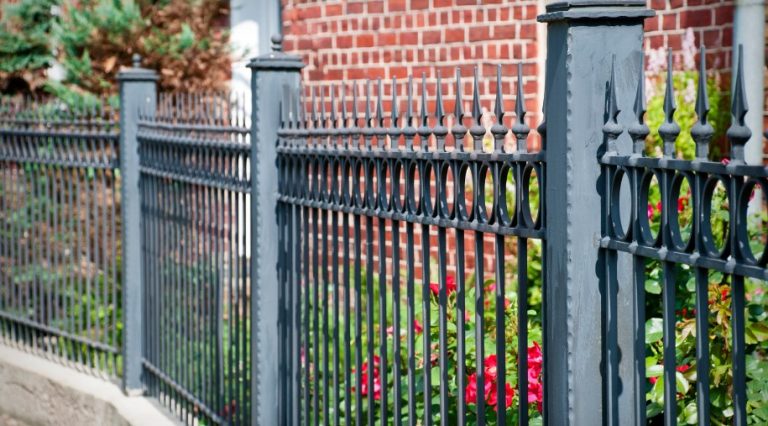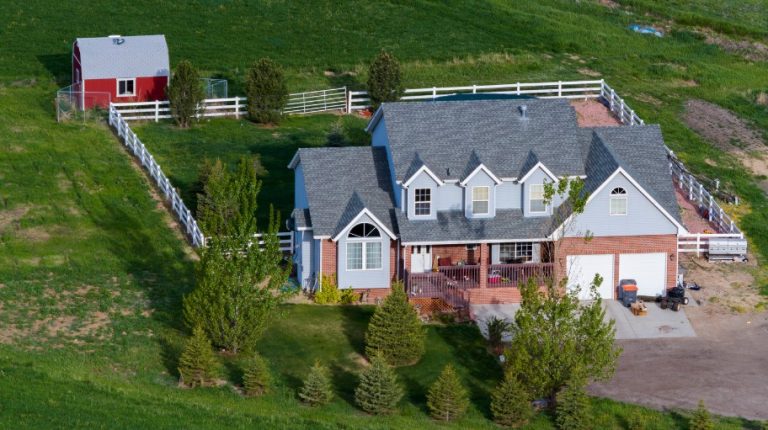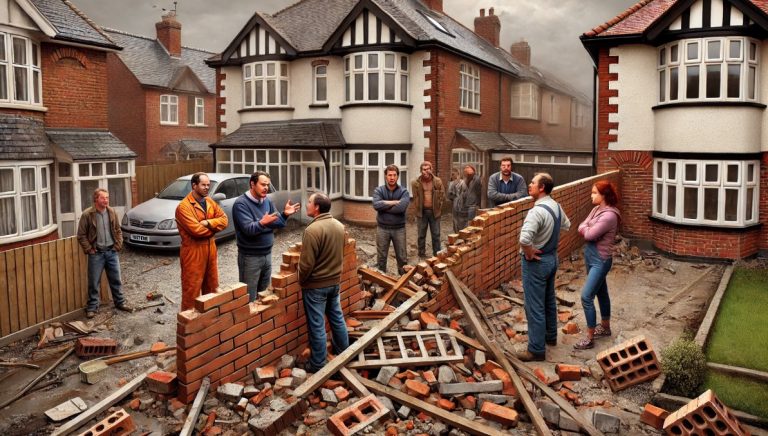Disputes over fences and property boundaries between neighbours are a common occurrence in the UK. Whether you’re looking to install a new fence, repair an existing one, or settle a boundary disagreement, it’s essential to be well-versed in the current fencing laws.
With updates to fencing regulations coming into effect in 2024, homeowners should be aware of their rights and obligations when it comes to fence ownership, maintenance, and boundary disputes.
In this guide, I’ll walk you through the key rules and regulations regarding fences between neighbours in the UK, helping you navigate these often tricky situations.
What Are the Key Laws on Fencing Between Neighbours in the UK?
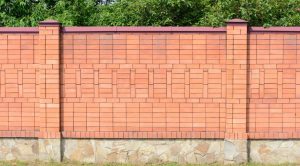
When it comes to installing, maintaining, or replacing fences between properties in the UK, several key laws and regulations govern how property owners should approach fencing between neighbours.
Understanding these laws is essential for avoiding disputes and ensuring that any changes you make are compliant with local and national regulations. Here’s a breakdown of the most important fencing laws between neighbours in the UK.
1. Property Ownership and Fence Ownership
One of the first things to determine when dealing with fencing between neighbours is fence ownership. The deeds to your property typically specify who owns the boundary fence or wall. Ownership is usually indicated by a ‘T’ mark on the property plan:
- If the leg of the ‘T’ is on your side of the boundary line, it means you own the fence and are responsible for its maintenance.
- If the ‘T’ appears on both sides of the boundary line (sometimes called a ‘party fence’), the fence is shared, and both parties are responsible for its upkeep.
If no such markings exist in your property deeds, ownership is determined either by agreement between the neighbours or by historical maintenance—meaning the person who has traditionally taken care of the fence may be considered the owner.
2. Legal Fence Height Limits
UK law imposes strict regulations on the height of fences to ensure they don’t become a nuisance or safety hazard. The general rules are as follows:
- For back garden fences, the maximum height allowed without planning permission is 2 metres (6.5 feet).
- For front garden fences or any fence near a public road or footpath, the maximum height is typically 1 metre (3.3 feet).
Exceeding these height limits requires planning permission from your local council. If your fence is taller than the allowed height and you don’t have permission, you could be asked to take it down or lower it to comply with the rules.
In conservation areas or if your property is a listed building, additional restrictions may apply. These areas often have specific regulations about the types of materials and heights allowed for fences to preserve the character of the location.
3. Boundary Lines and F2ence Placement
The placement of a fence on or near the boundary line is a critical issue when it comes to fencing laws. If you intend to build a fence directly on the boundary line, you must have your neighbour’s agreement, as it will technically be a shared fence.
If you build the fence within your own property boundary, you retain ownership, and your neighbour has no legal claim to it. However, even in this scenario, it’s courteous and advisable to inform your neighbour about your plans to avoid any future disputes. A common practice is to leave a small gap between the fence and the boundary line to ensure it’s entirely on your property.
In some cases, fencing that is erected directly on the boundary without mutual consent could lead to legal disputes. It’s always best to consult your property deeds and discuss the issue with your neighbour before proceeding with any construction.
4. Shared Fences and Responsibilities
If a fence is shared between two properties, both neighbours are typically responsible for its maintenance and any repairs or replacements. However, UK law does not explicitly require both parties to contribute financially, unless they have previously agreed to do so.
In the absence of an agreement, the responsibility for repairs usually falls to the owner of the fence.
If the fence is jointly owned (indicated by a party fence or mutual agreement), any work on the fence, such as repairs, replacement, or painting, should be agreed upon by both parties. It’s important to communicate and reach an agreement with your neighbour before making any decisions about a shared fence.
5. Resolving Boundary Disputes
Boundary disputes between neighbours over fencing are quite common, but the UK legal system encourages parties to resolve disputes through mediation rather than legal action. If there is a disagreement over where the boundary line lies, you can refer to the property deeds or hire a professional surveyor to help determine the exact boundary.
In more serious disputes, boundary agreements can be drawn up with the help of solicitors. These agreements are legally binding and clarify who owns which part of the property. This can help avoid future conflicts.
If a neighbour builds a fence that you believe encroaches on your property, it’s advisable to address the issue calmly and directly with them. If the situation cannot be resolved through conversation, you may need to seek legal advice or mediation services to resolve the dispute.
6. Planning Permission Requirements
As mentioned, planning permission is required if you wish to build a fence that exceeds the legally permitted height, or if you live in a conservation area or have a listed property. The process for obtaining planning permission involves submitting an application to your local council, which will then review your plans to ensure they comply with local development rules.
You may also need planning permission for fencing that:
- Obstructs visibility near a road or junction.
- Is part of a front garden next to a highway.
- Could impact local wildlife, particularly if you live in a protected area.
Failure to obtain the necessary planning permission before building a fence could result in fines, and you may be asked to remove or alter the fence to comply with regulations.
7. Neighbour Consent for Fence Work
Although not always legally required, it is generally good practice to get your neighbour’s consent before carrying out any major work on a shared fence, such as rebuilding or painting.
If the fence sits on the boundary and is used by both neighbours, it is essential to discuss any changes and ensure mutual agreement. If your neighbour doesn’t agree, and the fence is jointly owned, you may need to pursue mediation to resolve the issue.
8. Right to a Fence
It’s important to note that there is no legal requirement for a property owner to have a fence. This means that if your neighbour removes a fence or decides not to replace it, you can’t force them to install a new one. However, you are within your rights to build a fence on your property as long as it complies with the relevant regulations regarding height and planning permission.
9. New Laws on Fencing Between Neighbours (2024)
From 2024, there are some updates to fencing laws aimed at clarifying property boundary disputes and making it easier for neighbours to resolve fencing disagreements. The new laws provide additional guidance on the responsibilities of property owners when it comes to shared fences and outline the processes for notifying neighbours when significant changes to fences are planned.
These updates also include provisions for boundary disputes, simplifying the legal procedures for resolving disagreements over fence placement and maintenance. The goal of the new laws is to reduce conflicts and ensure that neighbours can manage their boundaries more amicably.
Who Owns the Fence? – Understanding Boundary Fence Rules in the UK

One of the most common questions homeowners ask is, “Who owns the fence?” This question is at the heart of many neighbourly disputes, particularly when repairs or replacements are needed. The property title deeds are the primary source of information regarding fence ownership.
These deeds may show a ‘T’ mark that indicates which property is responsible for the maintenance and ownership of a fence. The leg of the ‘T’ points toward the property responsible for that boundary.
What if the Deeds Don’t Show a ‘T’ Mark?
In cases where there is no clear indication of fence ownership in the deeds, historical maintenance can provide clues. For example, if one neighbour has historically maintained a fence, it could imply ownership. However, this is not a legal rule, and disputes can arise if neighbours disagree.
If there’s no ‘T’ mark, and both parties believe the fence is jointly owned, it’s essential to have a mutual agreement on its maintenance and any potential replacements. Sometimes, neighbours informally agree on ownership, even if the deeds are unclear.
What Is the Legal Fence Height in the UK?

The height of your fence is regulated by UK law. Generally, you can erect a fence up to 2 metres (6.5 feet) tall without needing planning permission if it’s in your back garden. For front gardens, particularly those adjacent to public roads or footpaths, the legal limit is typically 1 metre (3.3 feet).
When Do You Need Planning Permission?
Planning permission is required if you want to build a fence taller than the allowed limits. For example, if you want to install a privacy fence that exceeds 2 metres in height for security reasons or personal preference, you will need to apply for permission from your local council.
Local planning authorities can impose restrictions, especially in conservation areas or if the property is a listed building. In such cases, even fences below the standard height limits may require special permission.
Why Are These Height Restrictions Important?
The height restrictions exist to ensure that fences do not obstruct light, interfere with the aesthetic of the neighbourhood, or create barriers that impede visibility on roads and footpaths. For instance, a tall front garden fence may obstruct a driver’s view, leading to potential accidents.
How to Resolving Fence Disputes Between Neighbours?

Fence disputes can easily escalate, turning what begins as a minor disagreement into a serious legal issue. Common points of contention include ownership, height, and location. If you’re in a situation where you and your neighbour can’t agree on fencing matters, it’s important to follow a clear process.
Step 1: Open Communication
The first and best step is to engage in an open and polite discussion with your neighbour. Many disputes can be resolved through conversation, especially if both parties are willing to compromise. For instance, if a fence is in disrepair, you might agree to split the cost of repairs or negotiate who should be responsible based on historical precedent.
Step 2: Mediation
If discussions fail, mediation is a next step. This involves bringing in an independent third party who helps facilitate a resolution. Mediation is less costly and less stressful than going to court, and it preserves the relationship between neighbours.
Step 3: Legal Action
As a last resort, legal action may be required. Taking a dispute to court can be expensive, and the decision will be out of your hands. Before pursuing legal action, it’s wise to consult a solicitor who specialises in boundary disputes. They can help assess the situation and advise on whether your claim is likely to succeed.
Fence Maintenance and Shared Responsibilities
The responsibility for fence maintenance generally falls on the owner, but this becomes more complicated when a fence is shared between two properties. If the boundary fence is shared, the cost of maintenance or replacement is typically shared as well. However, both neighbours must agree on the nature of the work before proceeding.
What if One Neighbour Refuses to Maintain the Fence?
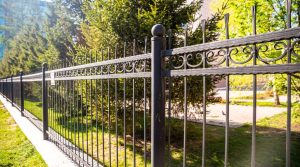
If your neighbour refuses to contribute or maintain their portion of the fence, you might choose to take on the repairs yourself. However, you should always discuss this with your neighbour first, as carrying out work on a shared fence without their consent could lead to further disputes.
It’s worth noting that the law doesn’t force a neighbour to build or maintain a fence, so it’s essential to approach the situation with understanding and patience.
Party Wall and Boundary Fence Laws
When it comes to property boundaries, the legal distinction between party walls and boundary fences is important in the UK. Both can cause disputes between neighbours, especially when one party decides to make changes or conduct maintenance. Understanding the Party Wall Act and how it applies to boundary fences is key to managing these situations amicably and legally.
What Is a Party Wall?
A party wall is a wall that is shared by two properties, usually dividing houses in a semi-detached or terraced arrangement. Party walls form a critical part of the structure for both properties, as they often provide support for buildings on both sides. Party walls are legally distinct from boundary fences, but they can sometimes intersect when fencing or walls are used to mark boundaries between gardens or properties.
For example, if a party wall extends into the garden or yard and serves as a divider, it might also play a role in the overall boundary structure. In such cases, both party wall laws and boundary regulations could apply simultaneously.
What Is a Boundary Fence?
A boundary fence is usually a non-structural division that marks the edge of a property, typically in gardens or open spaces. Unlike a party wall, a boundary fence is not shared structurally but can still be jointly owned or maintained, depending on where it is positioned.
In legal terms, the fence acts as a demarcation of property but does not usually bear any structural load like a party wall does. However, disputes over boundary fences are common, as these fences often sit along shared property lines, raising questions about ownership, maintenance, and replacement.
The Party Wall Act (1996)
The Party Wall Act 1996 is a piece of legislation that regulates any changes, work, or repairs made to party walls, boundary walls, or structures near or along property boundaries. It outlines the rights and responsibilities of both property owners when it comes to shared walls or boundaries. The purpose of the act is to prevent disputes when one neighbour wants to make changes that could affect the other’s property.
Under this law, if you intend to carry out any work on a party wall—whether it’s repairs, alterations, or extensions—you must notify your neighbour in writing at least two months before the work begins. This is known as a Party Wall Notice.
The Party Wall Act covers:
- Building a new wall on the boundary between two properties.
- Cutting into a party wall (for example, to install a beam or to extend a room).
- Excavating near the boundary (within a certain distance) that could affect the structural stability of your neighbour’s property.
- Demolishing and rebuilding a party wall.
Your neighbour has the right to agree or disagree with the proposed work. If they disagree, a Party Wall Agreement will need to be drawn up, often involving a surveyor who acts impartially for both parties to resolve the matter.
Do Party Wall Laws Apply to Boundary Fences?
While the Party Wall Act specifically governs structural walls that affect both properties, it can sometimes apply to boundary fences, particularly if the fence is integral to the supporting structure of a party wall or if it shares any load-bearing functions.
For instance:
- If a garden wall serves as a boundary and supports a fence or structure that impacts both properties, the Party Wall Act may be invoked if changes or repairs are required.
- In cases where a boundary fence sits on a shared boundary but does not carry a structural load, the Party Wall Act usually doesn’t apply. However, the ownership and maintenance of the fence are governed by property deeds and neighbourly agreements.
What’s the Difference Between a Party Wall and a Boundary Fence?
A party wall is typically a structural wall shared between two properties, like the wall between terraced or semi-detached houses. A boundary fence, on the other hand, is usually a non-structural division between gardens or other property lines. The Party Wall Act applies primarily to walls but can also include certain types of fences and barriers, particularly when they are part of a larger structure.
What to Consider Before Building a New Fence?

Before you embark on building a new fence, there are several legal and practical considerations to take into account. Fences not only serve as boundaries between properties, but they also influence aesthetics, privacy, and neighbourly relations. To avoid disputes and ensure your new fence complies with UK regulations, here’s what you need to think about:
1. Identifying Property Boundaries
The first step in building a new fence is understanding exactly where your property’s boundaries lie. Installing a fence on your neighbour’s property, even unintentionally, can lead to legal disputes. Property deeds often contain information about boundary lines, but if there’s any ambiguity, you may need to hire a surveyor to clearly demarcate the boundary.
Once the boundary is identified, it’s advisable to build the fence just inside your property line to prevent future conflicts. If you plan to build the fence directly on the boundary line, you’ll need to have an agreement with your neighbour, as it will be considered a shared structure.
2. Consulting Your Neighbour
Even if the fence will be built entirely on your property, it’s courteous (and sometimes legally necessary) to inform your neighbour about your plans. Doing so ensures transparency and reduces the chances of disputes. While it’s not always legally required to obtain their consent, involving your neighbour in the decision-making process can foster a good relationship and avoid potential friction.
If the fence will be a shared boundary fence, it’s even more important to collaborate with your neighbour, particularly if the costs will be shared or if they have specific preferences regarding the fence’s appearance, height, or materials.
3. Checking Local Council Regulations
Before you start building, you must check local council regulations regarding fences. While UK national law allows you to build a fence up to 2 metres in height in your back garden without planning permission, local councils may have additional restrictions. For example, in conservation areas or for listed buildings, stricter rules may apply, and you could need special permission.
For front gardens or fences near public roads, the height limit is generally 1 metre. If you want to exceed these heights, you’ll need to apply for planning permission from your local council. Additionally, if your property is near a public pathway or road, there may be further restrictions to ensure that the fence doesn’t obstruct visibility.
4. Fence Height and Privacy Considerations
The height of the fence plays a significant role in privacy and aesthetics. A taller fence may provide more privacy, especially in areas where houses are close together, but could also block sunlight or views. While 2 metres is the maximum height allowed without planning permission, you’ll need to consider how this might affect your relationship with your neighbour. For example, a very tall fence might block natural light to your neighbour’s garden or home, leading to complaints.
Discussing your plans with your neighbour in advance can help mitigate these concerns. If both of you agree on the need for additional privacy, you may be able to construct a taller fence with mutual understanding and, if necessary, approval from the council.
5. Materials and Style
When selecting materials and the style of your fence, you’ll need to think about both durability and aesthetics. Common materials for fences include:
- Wood: Popular for its natural look and privacy, but requires regular maintenance.
- Vinyl or PVC: Low maintenance, durable, but may not be as visually appealing for all homeowners.
- Metal (wrought iron or aluminium): Durable and stylish, but often offers less privacy.
The style of the fence should ideally complement the overall look of your property and the neighbourhood. Some neighbourhoods or councils might have aesthetic restrictions, so it’s important to ensure that the materials and style you choose align with local guidelines or the community’s standards.
6. Legal and Shared Responsibilities
If the fence is built on the boundary, it becomes a shared fence, meaning that both you and your neighbour have equal responsibility for its upkeep. In such cases, it’s important to clarify in advance who will be responsible for maintenance and repairs. Ideally, you’ll come to a written agreement on these points before construction begins to avoid disagreements later.
When a fence is entirely on your property, you will be solely responsible for its maintenance. However, even if it’s your fence, your neighbour’s approval might be necessary if the fence will significantly affect their property or access to light and air.
7. Planning Permissions and Covenants
Even if your fence adheres to the general height regulations, you may need planning permission in certain circumstances. For example, if you live in a conservation area or own a listed building, you may face restrictions on the materials or height of the fence, or be required to get approval from local authorities before beginning work.
Additionally, some properties may be subject to restrictive covenants—legal agreements attached to the land that could limit your ability to build certain structures, including fences. These covenants are often put in place by developers or previous owners and may dictate the type, height, or even the presence of fencing. Checking the property deeds for such covenants is essential before proceeding with any construction.
8. Planning for Future Maintenance
When planning a new fence, consider the long-term maintenance requirements. Wooden fences, for instance, may need regular treatment or replacement after a few years due to weather damage or rot. Vinyl or metal fences, though more expensive initially, tend to require less maintenance over time.
It’s important to factor in these costs when deciding on materials. If you’re building a shared fence, ensure you and your neighbour are on the same page regarding who is responsible for ongoing maintenance.
9. Neighbourhood Aesthetics and Community Guidelines
While you may have a specific design in mind, it’s important to consider the overall aesthetic of your neighbourhood. Some neighbourhoods have homeowner associations or community rules that govern the appearance of fences. These guidelines may include restrictions on materials, colours, or even the height of the fence.
Ignoring these guidelines could lead to fines or legal action, so it’s wise to check with your community’s governing body or the local council before committing to a particular design.
10. Insurance and Liability
When building a new fence, you should also consider the insurance implications. In the event that the fence causes damage—either during construction or after installation—you could be held liable for the costs. Make sure that your home insurance covers accidental damage or liability related to your fence.
If the fence is installed on a shared boundary and there is a dispute later on, insurance could also play a role in resolving who is responsible for any damage or repairs.
Conclusion
Understanding the laws on fencing between neighbours in the UK is essential for maintaining peaceful relations and avoiding costly disputes. Whether it’s determining who owns the fence, adhering to boundary fence rules, or resolving disagreements, knowledge of the regulations ensures that you stay within legal boundaries.
With the new laws on fencing between neighbours UK coming into effect in 2024, now is the perfect time to review your responsibilities and rights. By following these guidelines, you can navigate fencing issues smoothly and preserve good relations with your neighbours.
What Are the FAQ’s About Laws on Fencing Between Neighbours?
What happens if a neighbour refuses to maintain their fence?
If your neighbour is responsible for a fence and refuses to maintain it, you can start by discussing the issue with them. If they remain uncooperative, mediation might help resolve the problem. Legally, you cannot force them to repair or maintain the fence unless it’s causing damage to your property.
Can I paint my neighbour’s fence facing my property?
No, you cannot paint or alter your neighbour’s fence without their explicit permission, even if the fence faces your side of the property. It’s best to get their consent before making any changes.
Who pays for a shared fence replacement?
Both neighbours typically share the cost of replacing a boundary fence. However, it’s important to agree on the costs and type of replacement beforehand to avoid disagreements.
What are the rules on fence height near public pathways?
Fences near public pathways are subject to stricter height restrictions, usually around 1 metre (3.3 feet). Higher fences may require planning permission from the local council, particularly if they obstruct visibility for drivers or pedestrians.
Can I build a fence on the exact boundary line?
It’s best to avoid building a fence directly on the boundary line unless you have an agreement with your neighbour. Building the fence slightly inside your property line reduces the chances of future disputes.


